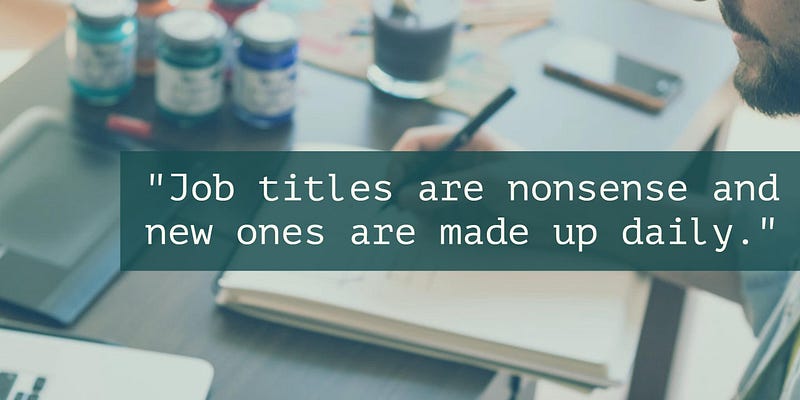
For much longer than was in any way reasonable, my Mom described my vocation as “Webmaster.” While it made me grin every time I heard it, it was also true that I didn’t really have a better description that made sense outside of our industry. “I’m an experience designer,” was generally met with blank stares and occasionally, eye rolls.
While I wasn’t too worried if Aunt Midge understood my career, I do believe that if you can’t explain something simply and clearly then you probably don’t understand it that well. And being able to succinctly describe the value you provide seems like something we should all be able to do.
Why does it matter?
It’s becoming more and more accepted that design is now critical to success in the business world. Companies are paying attention to concepts like design thinking, visual modelling, customer experience, and prototyping. They’re looking for individuals with the expertise to help them, but how do they find them? How do they sift through the avalanche of applicants a job posting for a designer will elicit to find the candidates that can actually help them?
__________ needed urgently?
While I may see myself as a designer, that designation is so broad it’s effectively useless in describing the value I want to bring to a project. Many of us tend to think about what we do from our own point of view until we go to look for a job. Since prospective employers tend to communicate through job titles and descriptions, we’re suddenly faced with a search field asking us what we think someone else would call what we do.
Designers needing to unravel and translate the needs of a client is not new or unusual, so we just need to deconstruct the problem. For that purpose I use the following framework, and I’m sharing it here in the hopes you might find it useful too.
We are what we repeatedly do
I tend to break design skills down into three broad areas. It’s important to note that I don’t consider these siloed; they work together and we’re talking about relative strengths in them rather than complete specialization.
The first is area is aesthetic. Let’s just accept the fact that NONE of us listened to our grandmothers and we do, in fact, judge books by their covers. I know several people who base the majority of their wine buying decision on how pleasing they find the label. You might consider these people misguided, but I consider them honest (and maybe not that into wine). I don’t mean to suggest that form and function are somehow unrelated or worse, inversely proportional. I’m saying that some people are really gifted with type, colour, and composition.
So function obviously, is the second area. Steve Jobs famously said, “Design is how it works.” I don’t presume to disagree with the great one, but I would add that he was working with the general public’s understanding of design at the time — that designers just “prettied things up.” Some people, including me, would argue that when something is truly beautiful it also tends to work exceptionally well. However for that to happen functionality must be part of the process. What is the problem the end user is trying to solve? What order are they likely to approach it in? What kind of affordances should be present? These are the functional considerations that seem to come naturally to some of us, but are more likely the product of interest and years of practice.
That brings us to emotional design. Another way to describe this is as the experience of a design, but that term is often tangled up with UI and I think emotional design is clearer for our purposes. Obviously both aesthetics and functionality play a large role here (remember I said they overlap?), but this skill goes beyond how a design looks and works. Got a knack for adding snappy writing to your work? Understand how to combine the way something works and looks to elicit a specific reaction or cultivate a perception? Do you know what is appropriate for your audience at the point in time when they’ll be encountering your work? This is the sometimes obvious, sometimes opaque art of designing for emotions.
Am I forgetting something? Probably. Feel free to #ragetweet suggestions to me later.
Your work should provide a thesis
Within the three areas described above, you likely have specific strengths and weaknesses. If you’re equally awesome at all three, then you are a special unicorn. Understanding where those strengths lie is important to crafting a message about the value you bring and triggering recognition of that value in a potential employer or client.
Job postings for UX designers for example tend to skew on the functional/emotional side, but UI/UX might be more aesthetic/emotional. Positions that come with the Senior Designer title could be mostly aesthetic, but who knows? Job titles are nonsense and new ones are made up daily. I suggest throwing a wide net and looking for differentiation in the descriptions.
When you see something that looks like a good fit, provide them with a resume or portfolio that shows how you’ll meet their challenge rather than a random collection of your best screenshots and links. Helping them understand what problem you were solving and what skills you used to solve them is the best way I know of to convey the value you’re offering.
Seems basic, but all too often I see designers that have trouble articulating the value they provide in terms that make sense to the people trying to find and hire them. After all, you really should be able to answer the question, “what would you say you do here?”

Kurt Krumme is a User Experience Lead who’s spent most of the last decade creating websites and apps for clients ranging from small not-for-profits like Peace One Day to to Fortune 500 companies including Sony and FedEx. These days he gives talks, writes articles, and helps clients keep the focus on their users, where it should be.
Originally published at blogs.adobe.com.


